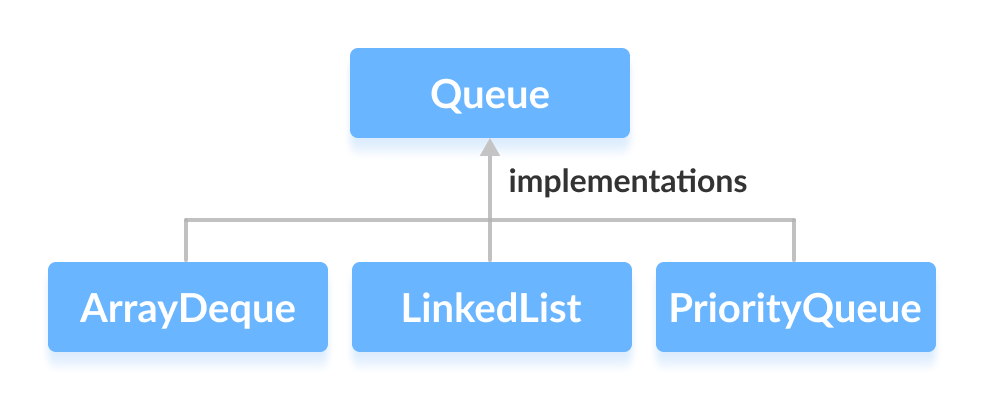(Java programming Example for Beginners)
Java Queue Interface
In this tutorial, we will learn about the Java Queue interface and its methods.
The Queue interface of the Java collections framework provides the functionality of the queue data structure. It extends the Collection interface.
Classes that Implement Queue
Since the Queue is an interface, we cannot provide the direct implementation of it.
In order to use the functionalities of Queue, we need to use classes that implement it:
- ArrayDeque
- LinkedList
- PriorityQueue

Interfaces that extend Queue
The Queue interface is also extended by various subinterfaces:
DequeBlockingQueueBlockingDeque

Working of Queue Data Structure
In queues, elements are stored and accessed in First In, First Out manner. That is, elements are added from the behind and removed from the front.

How to use Queue?
In Java, we must import java.util.Queue package in order to use Queue.
// LinkedList implementation of Queue
Queue<String> animal1 = new LinkedList<>();
// Array implementation of Queue
Queue<String> animal2 = new ArrayDeque<>();
// Priority Queue implementation of Queue
Queue<String> animal 3 = new PriorityQueue<>();
Here, we have created objects animal1, animal2 and animal3 of classes LinkedList, ArrayDeque and PriorityQueue respectively. These objects can use the functionalities of the Queue interface.
Methods of Queue
The Queue interface includes all the methods of the Collection interface. It is because Collection is the super interface of Queue.
Some of the commonly used methods of the Queue interface are:
- add() – Inserts the specified element into the queue. If the task is successful,
add()returnstrue, if not it throws an exception. - offer() – Inserts the specified element into the queue. If the task is successful,
offer()returnstrue, if not it returnsfalse. - element() – Returns the head of the queue. Throws an exception if the queue is empty.
- peek() – Returns the head of the queue. Returns
nullif the queue is empty. - remove() – Returns and removes the head of the queue. Throws an exception if the queue is empty.
- poll() – Returns and removes the head of the queue. Returns
nullif the queue is empty.
Implementation of the Queue Interface
1. Implementing the LinkedList Class
import java.util.Queue;
import java.util.LinkedList;
class Main{
public static void main(String[] args){
// Creating Queue using the LinkedList class
Queue<Integer> numbers = new LinkedList<>();
// offer elements to the Queue
numbers.offer(1);
numbers.offer(2);
numbers.offer(3);
System.out.println("Queue: " + numbers);
// Access elements of the Queue
int accessedNumber = numbers.peek();
System.out.println("Accessed Element: " + accessedNumber);
// Remove elements from the Queue
int removedNumber = numbers.poll();
System.out.println("Removed Element: " + removedNumber);
System.out.println("Updated Queue: " + numbers);
}
}
Output
Queue: [1, 2, 3] Accessed Element: 1 Removed Element: 1 Updated Queue: [2, 3]
2. Implementing the PriorityQueue Class
import java.util.Queue;
import java.util.PriorityQueue;
class Main{
public static void main(String[] args){
// Creating Queue using the PriorityQueue class
Queue<Integer> numbers = new PriorityQueue<>();
// offer elements to the Queue
numbers.offer(5);
numbers.offer(1);
numbers.offer(2);
System.out.println("Queue: " + numbers);
// Access elements of the Queue
int accessedNumber = numbers.peek();
System.out.println("Accessed Element: " + accessedNumber);
// Remove elements from the Queue
int removedNumber = numbers.poll();
System.out.println("Removed Element: " + removedNumber);
System.out.println("Updated Queue: " + numbers);
}
}
Output
Queue: [1, 5, 2] Accessed Element: 1 Removed Element: 1 Updated Queue: [2, 5]
Java tutorials for Beginners – Java Queue Interface
Two Machine Learning Fields
There are two sides to machine learning:
- Practical Machine Learning: This is about querying databases, cleaning data, writing scripts to transform data and gluing algorithm and libraries together and writing custom code to squeeze reliable answers from data to satisfy difficult and ill defined questions. It’s the mess of reality.
- Theoretical Machine Learning: This is about math and abstraction and idealized scenarios and limits and beauty and informing what is possible. It is a whole lot neater and cleaner and removed from the mess of reality.
Disclaimer: The information and code presented within this recipe/tutorial is only for educational and coaching purposes for beginners and developers. Anyone can practice and apply the recipe/tutorial presented here, but the reader is taking full responsibility for his/her actions. The author (content curator) of this recipe (code / program) has made every effort to ensure the accuracy of the information was correct at time of publication. The author (content curator) does not assume and hereby disclaims any liability to any party for any loss, damage, or disruption caused by errors or omissions, whether such errors or omissions result from accident, negligence, or any other cause. The information presented here could also be found in public knowledge domains.
